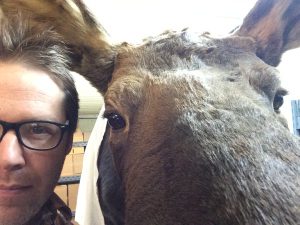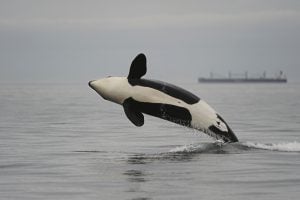
People & Culture
Canadians share their love for museums with selfies
#MuseumSelfie trended on Twitter January 20th as people the world over shared their snaps.
- 564 words
- 3 minutes
Science & Tech
Visitors can "swim" under the Salish Sea with holographic orca and learn about the noise pollution threatening the health of these endangered cetaceans

Don your headset, and enter the dome. Take a deep breath, and launch yourself into the depths of the Salish Sea in the northwest Pacific Ocean. As your eyes adjust to this underwater world, you suddenly realize you are not alone. For here, there be orcas. Southern resident killer whales, to be specific. “Critical Distance” is an augmented reality experience at the Smithsonian in Washington, D.C., that allows participants to meet holographic versions of J-pod, a group of 24 endangered orcas living around the Georgia Strait, the San Juan Islands, the lower Puget Sound and the southern Canadian Gulf Islands. (The last population count in 2020 put the total southern resident killer whale population in the Pacific Northwest at just 73 individuals.)
This collective of orcas that surrounds you is a tight-knit family. There are mothers and children, grandmothers and aunts and cousins. They’re life-size, engaging in the same behaviours as the real J-pod. Immersed in their world, you join family members as they swim, play and hunt for salmon. All the while, they’re communicating with each other — and figuring out the seascape they’re swimming in — by echolocation. In your AR bubble, when you reach out and touch them, they glow.
“It’s pretty spectacular,” says Amy Zimmerman of Mayne Island, B.C., who wrote, co-produced and co-developed the AR experience. “It’s the first time anyone will ever be able to ‘swim’ with the southern resident orcas.”
But this interactive experience soon reveals a darker side to the killer whales’ reality. Gradually, boats start to pass overhead. At first, it’s just kayaks, which the orcas use for echolocation. But the vessels get progressively bigger and louder, disrupting the orcas’ sense of their underwater home. The whales start to lose their vision, which becomes distorted as the sound increases in volume. Your vision becomes similarly blurry. “It’s simulating what it’s like for them when they’re swimming with one another and they’re trying to hunt and echolocate and they essentially lose their sight,” says Zimmerman.
As the largest of the boats passes over, the noise pollution climaxes and the family of orcas can no longer see one another — and you can no longer see them. Standing in darkness, you better understand the breadth of the obstacles facing this incredible mammal — what it sees and, perhaps, how it might feel. But though “Critical Distance” is a disturbing experience, it’s also about hope and positive action. The power of AR provides a new way to engage the public with wildlife and get participants to think more deeply about how they might help. “Whether you live by the sea or whether you live inland, there’s always something we can do to help the orcas and our oceans as a whole,” says Zimmerman.
That’s why it’s so important to understand and experience what it means for orcas — and all cetaceans — when there’s a lot of noise under the ocean, Zimmerman explains. “More now than ever before, I feel that we really need to quiet the waters for them.”
This AR southern resident killer whale experience will be at the Smithsonian until June 2022 and is scheduled to come to Canada later in the year. It is produced by Vision3, Vulcan Productions and Microsoft.
Are you passionate about Canadian geography?
You can support Canadian Geographic in 3 ways:

This story is from the March/April 2022 Issue

People & Culture
#MuseumSelfie trended on Twitter January 20th as people the world over shared their snaps.

Wildlife
When one of the few remaining females of reproductive age in the southern resident population of North Pacific killer whales was found dead near Comox B.C. in 2014, an investigation was launched. The results highlight the challenges of protecting our most iconic marine mammals.

Travel
Engage your curiosity and fuel your imagination with a visit to one of these top Canadian treasure troves

People & Culture
Indigenous journalists are creating spaces to investigate the crimes committed at Indian residential schools, grappling with unresolved histories and a reckoning that still has a long way to go